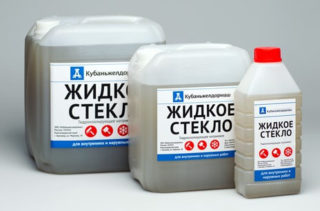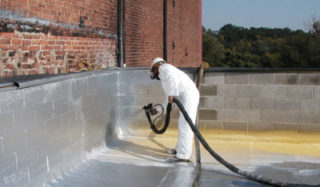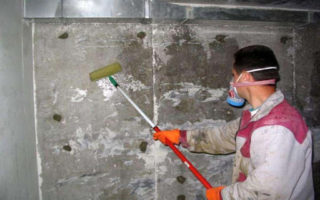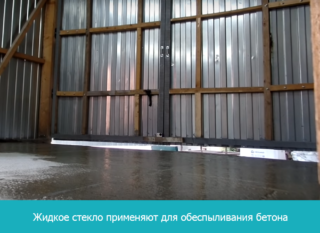To improve the performance of concrete, various plasticizers and additives are included in the solution. The use of water glass is one of the ways to increase the moisture resistance of the cement mixture.
Liquid glass for concrete and mortar

Liquid glass (WG) is an alkaline solution of sodium, potassium or lithium silicates. The composition is well known as a silicate adhesive. The viscous mixture dries to a transparent moisture-proof coating. The properties of the additive depend on the chemical composition of the base:
- Sodium - provides anti-corrosion, water-repellent and antiseptic properties.
- Potassium - protects concrete from acids and open fire.
- Lithium - Used to resist high temperatures, less commonly used than other metals.
- The combined composition of sodium and potassium in the correct proportions gives the mixture the positive qualities of both substances.
The concrete solution is durable, frost-resistant and durable. During operation, its strength characteristics deteriorate due to the effects of precipitation and ground moisture. Through the capillaries in the material, water rises inward. When frozen, it expands and creates cracks.
To prevent the process, structures are waterproofed. Processing concrete with liquid glass is one of the ways to protect it from moisture. The composition fills the pores, prevents water absorption. This method is widely used when processing walls and floors located below ground level, for bases flooded by groundwater.
A potassium and combination mixture is added to increase the heat resistance of the cement slurry. The modified composition is indispensable for laying stoves, fireplaces and chimneys. Also, water glass helps withstand the destructive reaction when it comes into contact with an acidic environment.
Scope and application features
- Waterproofing of foundations, ceilings, floors, joints of wall structures.
- Repair and imparting water-repellent properties to the surface of swimming pools, sewerage networks, wells.
- Adding to cement slurry in the manufacture of artificial stone to accelerate the setting and increase the strength.
- Plastering surfaces exposed to high temperatures (fireplaces, chimneys).
Among the advantages of liquid glass:
- Excellent adhesion to various building materials (wood, concrete). The result is a smooth surface with moisture resistant properties.
- Adding a concrete solution to the composition of the monolith increases the strength of the structure.
- The silicate additive has antiseptic properties and prevents the development of mold.
- Affordable cost, the composition is cheaper than polymer additives used for waterproofing foundations and concrete structures.
- Ease of use - silicate glass can be easily applied to any surface or added to the mixture.
Fast solidification requires an accelerated workflow. An accurate calculation of the proportions is necessary, otherwise the solution will not have the desired qualities.With a high concentration of liquid glass, concrete becomes brittle.
Ways of using liquid glass

There are two ways to increase the moisture resistance and fire resistance of concrete.
External processing
The moisture-proof composition, when applied to the surface of a concrete structure, penetrates into the smallest holes and crystallizes there. It prevents moisture from entering the material, protects against the action of acids and other aggressive compounds. Plaster with silicate additive increases the thermal insulation characteristics of the walls. The antiseptic qualities of ZhS do not allow mold and fungi to settle on the walls and basement rooms. Any type of foundation, a pool from a concrete bowl, a basement can be treated with a silicate solution.
Adding to concrete
The application of impregnation protects the outer part of the structure, in order to improve the hydrophobic characteristics of the entire mass of concrete, water glass is added to the solution. The maximum amount should not exceed 10%. An excess of the additive leads to an early destruction of the structure. The preparation of concrete mortar with silicates always takes place in small portions so that they can be used before crystallization begins.
Preliminary preparation and general recommendations
Before applying the waterproofing layer, the surface is cleaned of the old coating, eliminating peeling and contamination. The procedure will provide deeper penetration of the moisture-protective composition. Any cracks found should be repaired and the protrusions removed. It is recommended to pre-prime the concrete base with liquid glass diluted with water 1: 5. If the surface to be insulated is very smooth, it is brushed with a wire brush to roughen it up.
One of the requirements for waterproofing works is the air temperature. It should not fall below 5 ° C. The silicate composition is stored in a container into which it is poured at the factory. The remainder is carefully covered.
When preparing a solution on your own, information is needed as to how long the mixture will set. Proportions of liquid glass for concrete:
| Liquid glass content | Initial setting, min | Final solidification, h |
| 2-3% | 40-45 | 22-24 |
| 5% | 25-30 | 13-15 |
| 10% | 5-7 | 3-4 |
Diy do-it-yourself waterproofing composition preparation technology

To prepare the solution you will need:
- bucket;
- mixer nozzle for a perforator;
- roller or brush;
- measuring capacity.
It is necessary to mix silicate and cement mortar in the recommended proportions. In order not to violate the instructions, it is convenient to use a measuring container. The consistency of liquid glass is adjusted by adding cold water. The composition of the waterproofing mixture also includes cement and sand. The proportion for the treatment of wells is 1: 1: 1 (cement, ZhS sand), for other structures, the ratio of 1 liter of silicate to 10 liters of concrete is taken.
First, the dry ingredients of the grout are kneaded. Then dissolve the required amount of ZhS in the water prepared for the mixture. The solution is poured into dry components with continuous stirring with a mixer. You can add ready-made silicate to concrete, but the first method provides a more even distribution of the water repellent.
The waterproofing is applied with a roller or with a brush. Adjacent stripes should overlap each other. When processing walls and ceilings, a spray gun is used. It is more convenient for them to apply the composition to a vertical surface. An even coating is obtained.
The layer should not be thicker than 3 mm, if necessary, the solution is applied 2-3 times. It is important to wait until the surface is completely dry, then proceed with further waterproofing.
Safety at work

A solution of sodium silicates is not a toxic substance, but when working with it, you must follow the rules:
- Gloves and a protective suit are worn before mixing the formulations. If a drop of liquid glass gets on your skin, it may cause irritation.
- It is dangerous for the composition to come into contact with mucous membranes.Avoid contact with eyes and respiratory system. Goggles and a respirator are recommended as protection. In case of contact with eyes, rinse immediately with running water.
- Work with silicate glue is carried out outdoors or in a well-ventilated area.
- It is better to remove streaks from silicate additives immediately. It hardens quickly and is hard to peel off. Tools are thoroughly washed after finishing work.
Exposure to water and acid destroys concrete structures. Liquid glass is an effective and inexpensive waterproofing agent. It is applicable to various parts of a building, external treatment and changes in the characteristics of cement slurries.










Hello, how does liquid glass react to ultraviolet light? I wanted to work the courtyard filled with concrete, but the courtyard was on the sunny side. Thanks in advance for your reply
a lot has been written .. and in short, liquid glass for the manufacture of waterproofing mortar is applied in the amount of 4% of the weight of cement. those. if 400 kg of cement is used per cube of concrete, then 16 kg of liquid glass is added.